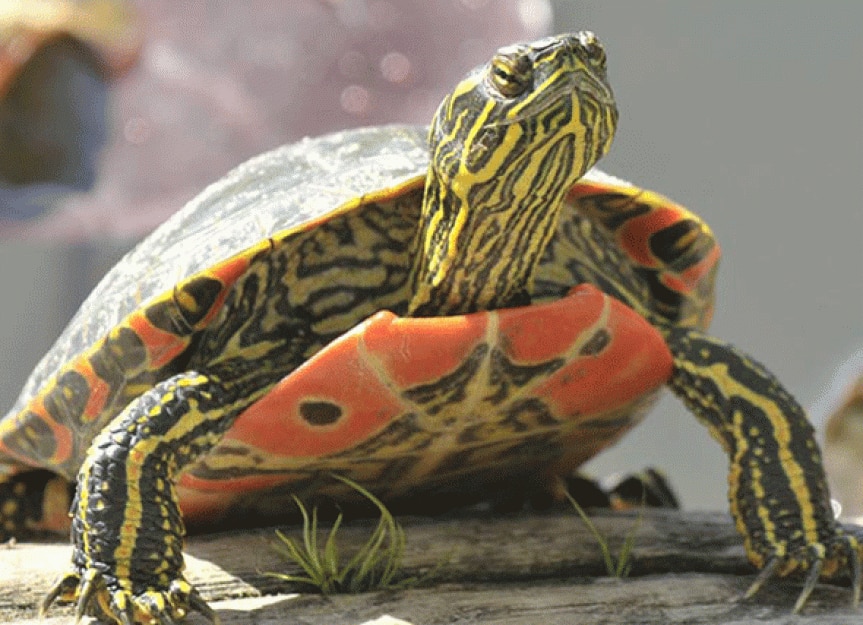Painted turtles are primarily aquatic, spending the majority of their time in water. They are known for their ability to swim with ease and are well adapted to life in lakes, ponds, and slow-moving streams.
With their webbed feet and streamlined shells, they navigate through the water effortlessly and are excellent swimmers. These turtles are also capable of basking on logs or rocks to thermoregulate, and they may occasionally venture onto land for nesting purposes.
But overall, painted turtles are aquatic creatures that thrive in watery habitats. Their natural instincts and physical adaptations make them highly adept at life in the water.
Characteristics Of Painted Turtles
Physical Appearance: Painted turtles have a distinct appearance with their brightly colored shells, which range from olive green to black. These shells are adorned with yellow and red patterns or stripes, making them highly noticeable. They have webbed feet with claws, allowing them to maneuver effectively in water. The upper part of their head and neck is typically black with yellow or red stripes. Painted turtles also have a distinguished yellow or red mark behind each eye.
Habitat: Painted turtles are predominantly aquatic and can be found in various bodies of water, such as ponds, lakes, and slow-moving rivers. They are well-adapted to both freshwater and brackish environments. These turtles prefer areas with abundant aquatic vegetation and basking spots, such as logs or rocks, where they can thermoregulate.
Diet: Painted turtles are omnivorous and have a diverse diet. They primarily feed on aquatic plants, such as algae, pondweed, and duckweed. They also consume various invertebrates, including insects, snails, crayfish, and small fish. Juvenile painted turtles tend to be more carnivorous than adults, gradually transitioning to a more herbivorous diet as they grow.
:strip_icc()/GettyImages-561461945-574a20573df78ccee1de80bd.jpg)
Credit: www.thesprucepets.com
Aquatic Adaptations Of Painted Turtles
| Shell Structure | The painted turtle has a well-developed shell that provides protection and buoyancy. The carapace, or top shell, is oval-shaped and smooth, allowing it to glide easily through water. The plastron, or bottom shell, is flat and flexible, enabling the turtle to swim effectively and navigate aquatic environments. |
| Limbs and Feeding Adaptations | Their webbed feet serve as paddles, assisting them in swimming and maneuvering underwater. They also have sharp claws which help them climb onto rocks or logs. Their long necks allow them to reach their heads out of the water to breathe and capture prey. Painted turtles have a carnivorous diet, feeding primarily on aquatic plants, insects, fish, and small amphibians. |
| Respiration | Painted turtles have adaptable respiratory systems. They possess internal gills as hatchlings, which are later replaced by well-developed lungs. While underwater, they can extract oxygen from the surrounding water through specialized tissues in their mouth and cloaca. |
Terrestrial Behaviors Of Painted Turtles
Nesting and Egg Laying: Painted turtles are primarily aquatic creatures, but they do exhibit terrestrial behaviors during certain activities. One such behavior is nesting and egg laying. Females leave the water and find suitable locations on land for their nests, usually in sandy or loose soil. They dig holes using their hind limbs and deposit their eggs, carefully covering them up to protect them from predators.
Basking and Sunning: Another terrestrial behavior commonly observed in painted turtles is basking and sunning. After spending long periods in the water, these turtles climb onto exposed rocks, logs, or other elevated surfaces to soak up the warmth of the sun. Basking helps regulate their body temperature and aids in digestion and Vitamin D synthesis.
| Overwintering |
|---|
| Painted turtles also demonstrate terrestrial behavior during the winter months. |
| In colder climates, they overwinter in the mud at the bottom of ponds or lakes, burying themselves in the soft sediment to survive the freezing temperatures. |
| During this time, painted turtles enter a state of metabolic depression, slowing down their heart rate and other bodily functions. |
| Once warmer temperatures return, they become active again and resume their aquatic lifestyle. |

Credit: wdfw.wa.gov

Credit: www.petmd.com
Conclusion
Painted turtles are indeed aquatic creatures, well adapted to live in various aquatic habitats. They possess unique physiological features and behaviors that enable them to thrive in water. Understanding their aquatic nature is essential for their proper care and conservation.
So, whether you’re considering keeping a painted turtle as a pet or simply curious about their natural habitat, recognizing their aquatic needs is key to ensuring their well-being.






Leave a Reply